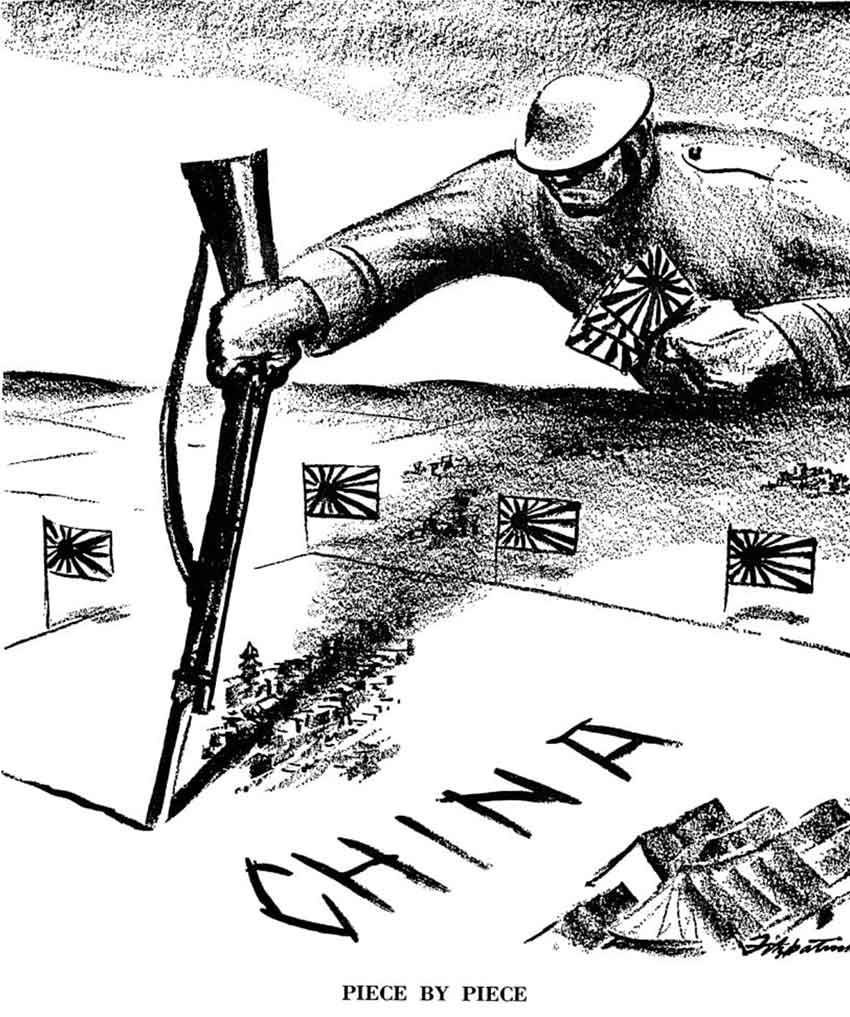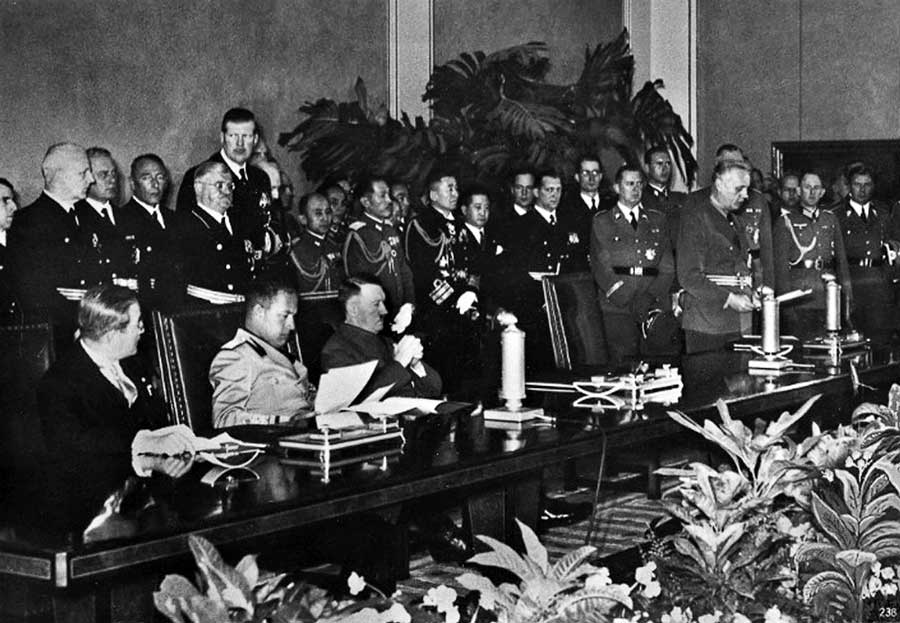- Military History
- Conflicts & Wars
- Second Sino-Japanese War
- Second Sino-Japanese War 1937-1945 (Summary)

Second Sino-Japanese War 1937-1945 (Summary) Japan sought conquest of China and the installation of a Japanese-controlled puppet government.
Featured Japan had been pursuing an aggressive policy of imperial expansion at the expense of China since 1931, and in 1932, annexed Manchuria as Manchukuo. The ongoing conflict erupted into a full-scale war, which merged with World War II in 1941. On July 7, 1937, Japanese troops stationed in North China fought with Chinese troops near the Marco Polo Bridge at Luguoqiao (Lukouchiao), just outside of Beijing (Peking).
The Japanese troops were ostensibly on night maneuvers, but the resulting "China Incident" had clearly been provoked by Japan as a pretext for a massive invasion. This, the start of the Sino-Japanese War, might also be deemed the true beginning of World War II.
The National Government Army of China, led by Generalissimo Chiang Kai-shek, numbered some 2 million troops; however, his troops were poorly equipped and poorly trained. A Communist guerrilla army of 150,000, supported them which sus pended its struggle against the Nationalists in order to fight the comm9n enemy, the Japanese invaders. Chinese forces faced a Japanese force of about 462,000 augmented by 150,000 Manchurians and Mongolians. The Japanese troops were well trained, equipped with the most modern weapons, and had superb leadership. The Manchurian and Mongolian auxiliaries, although not as well equipped or as well led, were still superior to the Nationalist Chinese forces. The Japanese army had a large reserve to call upon, and the nation was an industrial giant, its industries already geared for a major war of conquest.

On July 28, 1937, Japanese forces made quick work of Beijing and the city fell quickly. Tianjin (Tientsin) fell the next day, and from this point Japanese forces steadily marched west and south, brushing aside almost wholly ineffectual Chinese resistance. The westward-marching forces soon took the province of Chahar and part of Suiyuan. The force advancing southward closed in on Nanjing (Nanking), Hankou (Hankow; Wuhan), and Xi'an (Sían), but also met stiffer resistance from the Chinese regular army and from partisan force.
Stretched supply lines also hampered the Japanese advance. By December 27, 1937, Japanese troops had taken Jinan (Tsinan), capital of Shandong (Shantung) Province, which gave Japan control of the area north of the Yellow River.
While Japanese forces fought for the territory north of the Yellow River, an amphibious Japanese assault landed at Shanghai on August 8. Here, Chinese defenders resisted with great tenacity, forcing Japan to pour in more and more reinforcements. The Japanese air force unleashed heavy raids against the city, but the defenders kept the invaders pinned down on the beaches for a full two months. However, the pressure of yet more reinforcements wore down the defenders, and on November 8, 1937, Shanghai fell to the Japanese.

The only bright spot for the Chinese during 1937 was the Battle of Ping-xin-guan (P'ing-hsin-kuan) on September 25, in which the Japanese 5th Division was surprised and defeated in the Wutai Mountains (northern Shanxi [Shansi]) by the Chinese 115th Division, a communist unit of the Eighth Route Army. An important victory in itself, the triumph had significant propaganda impact, and it allowed the Communists to take control of northwest China. They established important Communist Chinese guerrilla bases behind Japanese lines. Despite this defeat, Japanese forces captured Nanjing on December 13 and launched an appalling orgy of murder, rape and senseless destruction. If anything, the rape of Nanjing instilled in the Chinese a will to resist that was fiercer than earlier in the terrible year.
A side event of the brutal invasion was the Panay incident on December 12, in which Japanese aircraft attacked British and U.S. gunboats moored near Nanjing. The USS Panay was sunk and a British boat was severely damaged. Not wishing to provoke a war with the United States, the Japanese subsequently apologized and paid an indemnity for the loss.

The year 1938 began with Japan renewing its offensive in northern China. The conquest of Shandong was complete before the end of January. The Japanese continued to advance toward Nanjing and Hankou, but were delayed by attacks from the regular Chinese army and by guerrilla forces. By April, the Japanese had control of the rail lines but little else leading to Nanjing and Hankou.
In April 1938, at Taierzhuang (Taierchwang), General Li Zongren (Li Tsung-jen) led regular and guerrilla forces exceeding 200,000 in an envelopment of a Japanese army of 60,000. After much fighting, the Japanese broke out, but at the cost of a third of their force. Although the victory was a cause for Chinese jubilation, the Japanese invaders quickly recovered and renewed the assault from the north in May and June. Suzhou (Suchow) fell on May 20, followed by Kaifeng on June 6. By the end of the month, the vital Beijing-Nanjing railroad was in Japanese hands. In the meantime, Nationalist leader Chiang Kai-shek made another bargain with the Communísts, agreeing to support another Communist force, the New Fourth Army; which was led in battle through east-central China by Yeh Ting (Yeh T'ing; 1897-1946).
From Kaifeng, Japanese forces marched west to capture the rail junction at Zhengzhou (Chengchow) to enable an advance down the railroad to Hankou. To fore stall this action, the Chinese purposely destroyed the dikes holding back the waters of the Yellow River during June and July, flooding the countryside, drowning many Japanese troops, destroying significant quantities of equipment, and bringing the advance to a halt. Almost immediately, however, the Japanese army shifted southward and recommenced the advance on Hankou. Although resistance by Chinese ground forces was bloody and determined, Japanese air support forced the surrender of Hankou, the temporary capital of Chiang's Nationalist government. Chiang Kai-shek evacuated the city and reestablished his capital and headquarters at Chongqing (Chungking) in the rugged Sichuan (Szechwan) Province. While this was taking place, a new Japanese amphibious force landed near Hong Kong on October 12 and quickly marched inland to take Guangzhou (Canton), which fell on October 21. China's two major seaports were now controlled by Japanese forces.
Although the Japanese army had inflicted devastating losses on the Chinese, by the beginning of 1939 the war was proving inconclusive. Vast tracts of China were occupied, but popular resistance took a heavy toll on the invaders. Doubtless, with an eye toward the much larger war that loomed ahead elsewhere, the Japanese high command changed its strategy, shifting from a program of rapid conquest to one of attrition. Before the end of 1939, Japanese forces captured all of China's remaining seaports to strangle the nation. By the beginning of 1940, only two tenuous supply routes fed into China: the tortuous Burma Road, winding up from British Burma (Myanmar) to Kunming, and a narrow-gauge railroad running from Haiphong, French Indochina, to Kunming.

Although Chiang Kai-shek and his unlikely allies, the Chinese communists, continued resistance, the Japanese established a puppet government at Nanjing for occupied China. It was presided over by a well-respected Chinese politician, Wang Jingwei (Wang Ching-wei; 1883-1944), who never brought about the defection of Chiang's supporters.
With much of China occupied, the Japanese moved against Indochina in June 1940. France, having surrendered to Germany, was in no position to resist Germany's ally Japan, and the Vichy administrators of French Indochina yielded permission to the Japanese to land forces. This closed the supply route from Haiphong to Kunming.
Next to close was the Burma Road. Japan and Great Britain were not yet at war, and the British, under threat of invasion from Germany, had no desire to begin warfare against Japan. When the Japanese demanded that the British in Burma close the Burma Road, Prime Minister Winston Churchill reluctantly acceded. China was thus cut off from the world.
Yet Chiang Kai-shek and communist leader Mao Zedong (Mao Tse-tung) refused to give up. Between August 20 and November 30, 1940, Mao led an intensive series of guerrilla raids in the provinces of Shanxi, Chahar, Hebei (Hopeh), and Henan (Honan), doing substantial damage to Japanese rear echelons. Japan, in the meantime, occupied Indochina during September and established bases from which it could make additional air attacks on Chinese territory and pour in more land forces. Shortly after the occupation, on September 26, U.S. president Franklin Roosevelt embargoed scrap iron and steel shipments to Japan, precipitating a sharp decline in U.S.-Japanese relations, even as Japan formally concluded the Rome-Berlin-Tokyo Axis with Nazi Germany and Fascist Italy on September 27.

Beginning in 1941, Japanese forces conducted periodic punitive raids against Chinese Communist forces. Over the next three years, these raids would keep the Chinese Communist Eighth Route Army continually on the defensive and would cost it some 100,000 casualties. To make matters worse, the Nationalist-Communist alliance, never very secure, broke down. When the New Fourth Army, operating south of the Yangtze River in Anhui (Anhwei), refused to cross the river to attack Japanese troops, Chiang Kai-shek moved Nationalist forces into the region. In response, in late December 1940, the New Fourth Army crossed the river, leaving only 10,000 troops and its headquarters on the south bank. Nationalist forces attacked this element, destroying it and creating a crisis in relations with Mao Zedong.
On the diplomatic front, the Japanese concluded a neutrality treaty with the Soviet Union on April 13, 1941, and the U.S. government froze Japanese assets in the United States on July 26. In a climate of increasingly hostile relations, Washington quietly approved the formation of the American Volunteer Group, better known as the Flying Tigers, a mercenary air force of about 100 U.S. fliers led by retired U.S. Army captain Claire L. Chennault. The deployment of the Flying Tigers was complete by December 1941. In the meantime, in October, Hideki Tojo became Japan's premier, completing the delivery of that nation's government into military hands. The stage for a world war was now fully set.

For the rest of the Sino-Japanese War, see our information in the World War II Pacific Theater category.
Second Sino-Japanese War 1937-1945 (Summary) - Quick Facts
- {{#owner}}
- {{#url}} {{#avatarSrc}}
{{name}} {{/url}} {{^url}} {{#avatar}} {{& avatar}} {{/avatar}} {{name}} {{/url}} - {{/owner}} {{#created}}
- {{created}} {{/created}}






















